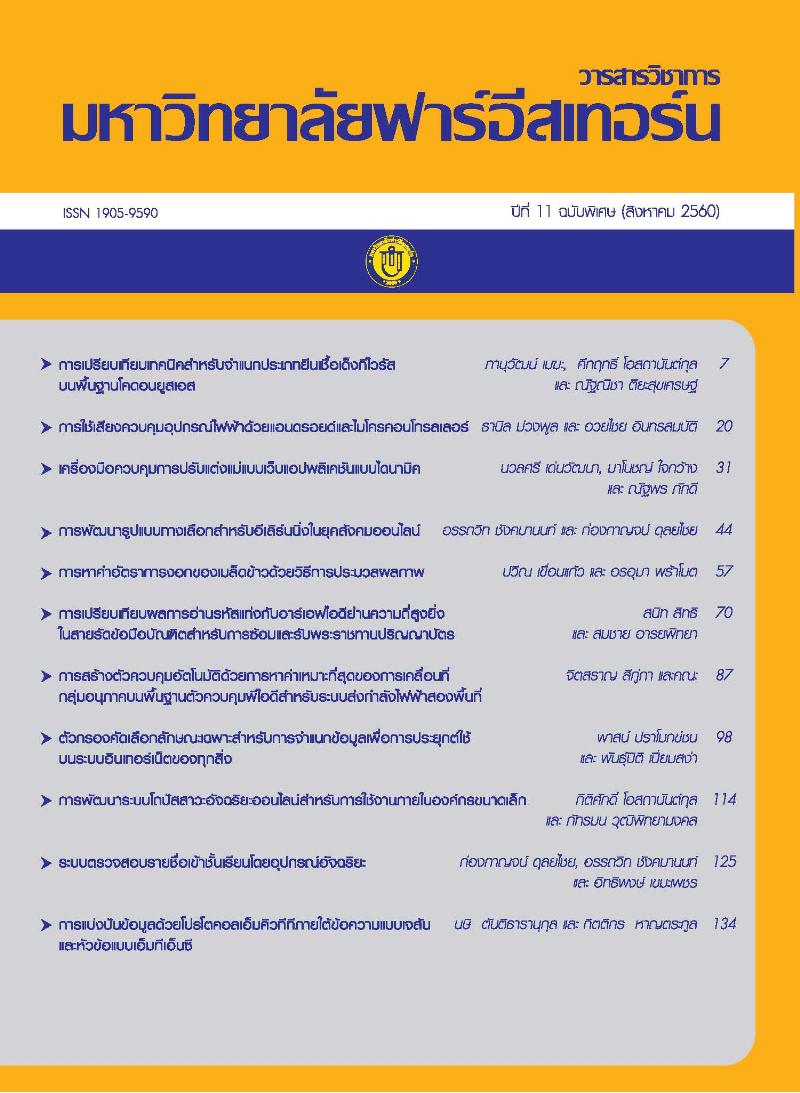การพัฒนาระบบโถปัสสาวะอัจฉริยะออนไลน์ สำหรับการใช้งานภายในองค์กรขนาดเล็ก
Main Article Content
Abstract
ระบบโถปัสสาวะอัตโนมัติในปัจจุบันเริ่มเป็นที่นิยมแพร่หลายในห้องนํ้าสาธารณะอาจจะด้วยเหตุผล
ของความสะอาดที่ต้องการชำระล้างโถปัสสาวะทุกครั้งหลังการใช้งานหรือการประหยัดทรัพยากรณ์นํ้าเพื่อ
ไม่ให้เปิดนํ้าทิ้งโดยไม่จำเป็น แต่โถปัสสาวะอัตโนมัติที่มีขายในท้องตลาดในปัจจุบันนั้นไม่มีการเก็บข้อมูล
การใช้งานไว้ซึ่งข้อมูลเหล่านี้สามารถบอกกับผู้ดูแลสถานที่ได้ว่าในแต่ละวันมีผู้ใช้งานโถปัสสาวะมากน้อย
เพียงใด ซึ่งนั่นก็หมายถึงความสะอาดโดยรวมของห้องนํ้าเช่นกัน ซึ่งบทความนี้ได้นำเสนอระบบโถปัสสาวะ
อจั ฉริยะที่ถูกพัฒนาโดยการใชง้ านไมโครคอลโทลเลอรเ์ ปน็ ตัวควบคุมและสงั่ การทำงาน โดยมีการเก็บขอ้ มูล
การใช้งานและแสดงผลผ่านทางอินเทอร์เน็ตเพื่อนำข้อมูลเหล่านั้นไปวิเคราะห์การใช้งานได้ต่อไป
ผลการทดลองของระบบโถปัสสาวะอัจฉริยะนั้นแสดงให้เห็นว่าระบบสามารถทำงานแทนระบบโถปัสสาวะ
อัตโนมัตทั่วไปได้และยังสามารถแสดงข้อมูลการใช้งานผ่านอินเทอร์เน็ตได้อย่างมีประสิทธิภาพ
An automatic urinal flusher is one of the most common automatic devices in a public toilet.
This might be because of the hygienic reason or to save clean water. However, automatic urinal
flusher which is known to the market does not provide us any usage information. In this paper,
an automatic smart urinal flusher is introduced. It is built from a microcontroller to control all
operations from detecting a user to flushing a solenoid value. Usage information here can be used
to see how often a urinal flusher has been used and even estimate how dirty of the toilet form the
number of usage. The usage data can also be predicted in the future in order to prepare toilets for
a new customer. The results show that the proposed system is working as good as an automatic
urinal flusher but it can even further provide the usage information as well.
Article Details
1. Any views and comments in the Journal of Social Innovation and Lifelong Learning are the authors’ views. The editorial staff have not to agree with those views and it is not considered as the editorial’s responsibility.
2. The responsibility of content and draft check of each article belongs to each author. In case, there is any lawsuit about copyright infringement. It is considered as the authors’ sole responsibility.
3. The article copyright belonging to the authors and The Far Eastern University are copyrighted legally. Republication must be received direct permission from the authors and The Far Eastern University in written form.
References
Floea, S. C. & Mois, G. (2015). A low-power wireless sensor for online ambient monitoring. IEEE Sensors Journal. 15(2),742-749, 2015
Brunelli, D. ; Minakov, I.; Passerone, R. & Rossi, M. (2014). POVOMON: An Ad-hoc Wireless Sensor Network for indoor environemntal monitoring. IEEE Workshop on Environmental, Energy, and Structural Monitoring System Proceedings. (pp. 1-6).
Nordic Semiconductor. (2016). Single chip 2.4GHz Transciever nRF24L01. Retrieved September 1, 2016, from http://www.nordic.com.
Shah, J. & Mishra, B. (2016), IoT enabled Environmental Monitoring System for Smart Cities. International Conference on Internet of Things and Applications (IOTA). (pp. 383-388). Maharashtra Institute of Technology, Pune, India, 22-24 Jan, 2016
Yang, Shuang-Hua ; Chen, Xi ; Chen, X. ; Yang, L. ; Chao, B. ; Cao, J. (2015). A case study of internet of things: A wireless household water consumption monitoring system. IEEE 2nd World Forum on Internet of Things (WF-IoT). Milan, 2015. (pp. 681-686).
Osathanunkul, K. ; Hantrakul, K ; Pramokchon, P. ; Khoenkaw P.; & Tantitharanukul, N., (2017) "Configurable automatic smart urinal flusher based on MQTT protocol," International Conference on Digital Arts, Media and Technology (ICDAMT), Chiang Mai, 2017, pp. 58-61.
Zanella, A. ; Member, S. ; Bui, N. ; Castellani, A. ; Vangelista, L. & Zorzi, M. (2014). Internet of Things for Smart Cities. IEEE Internet of Things. 1(1), 22-32, 2014

